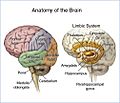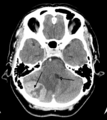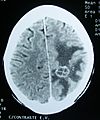Brain tumor facts for kids
A brain tumor is a growth of cells that forms inside the brain. These growths can be either benign (which means they are not cancer and usually don't spread) or malignant (which means they are cancer and can grow quickly). Brain tumors can affect how the brain works, leading to different symptoms depending on where they are located.
Contents
Types of Brain Tumors
There are many different types of brain tumors. Doctors classify them based on the kind of cells they start from and how fast they grow. Some common types include:
- astrocytoma
- glioblastoma multiforme
- oligodendroglioma
- ependymoma
- primary CNS lymphoma
- meningioma (These tumors usually start in the meninges, which are the protective layers around the brain and spinal cord.)
How Brain Tumors are Treated
The way a brain tumor is treated depends on several things. These include the type of tumor, its size, where it is located, and the person's overall health.
Surgery
Often, the first step in treating a brain tumor is surgery. Doctors try to remove as much of the tumor as safely possible. For some tumors, like many meningiomas, surgery might be the only treatment needed if the tumor is completely removed.
Radiation Therapy
For tumors that are harder to remove completely, or for malignant (cancerous) tumors, doctors might use radiation therapy. This treatment uses high-energy rays to kill tumor cells or stop them from growing. It's also called radiotherapy.
Medication
Sometimes, special medications are used to treat brain tumors. For example, a medicine called Temozolomide (also known as Temodar) is often used for certain types of brain tumors called gliomas, including Glioblastoma multiforme. These medications can help slow down the tumor's growth or shrink it.
Malignant tumors, like anaplastic astrocytoma and glioblastoma multiforme, usually need a combination of these treatments because they are more aggressive.
Images for kids
-
The main areas of the brain and Limbic system
-
CT scan of a brain tumor, with its diameters marked as an X. There is hypoattenuating (dark) peritumoral edema in the surrounding white matter, with a "finger-like" spread.
-
Micrograph of an oligodendroglioma, a type of brain cancer. Brain biopsy. H&E stain
See also
 In Spanish: Tumor cerebral para niños
In Spanish: Tumor cerebral para niños







